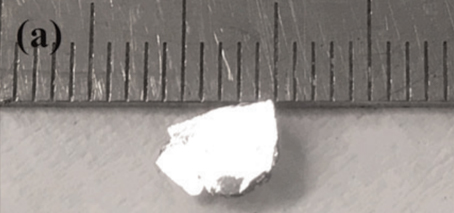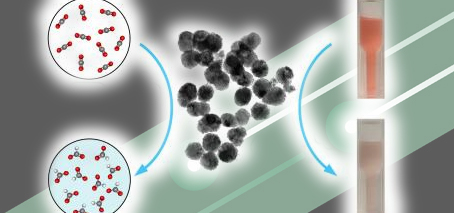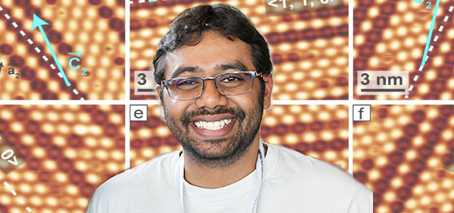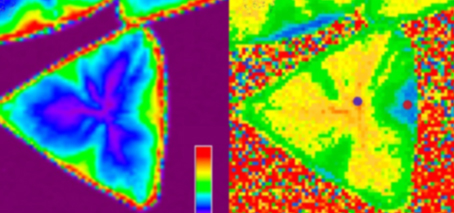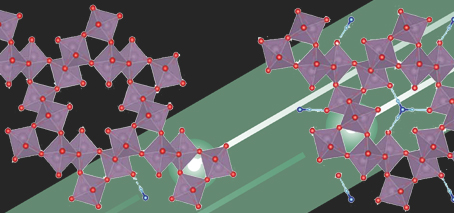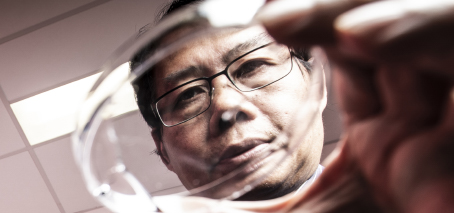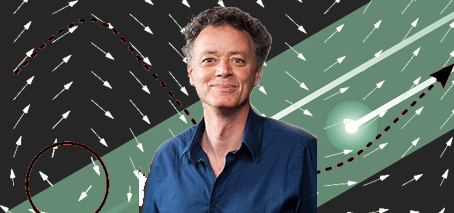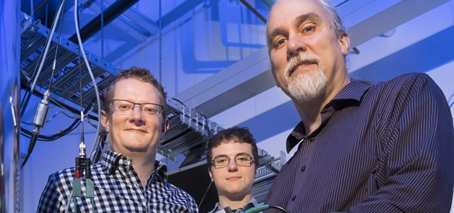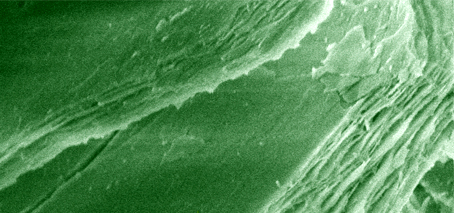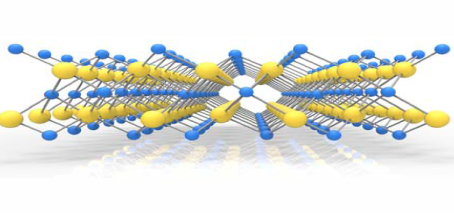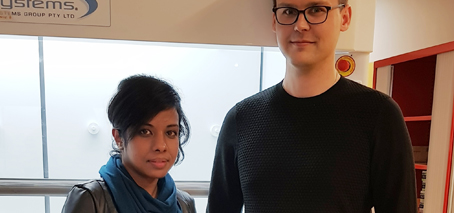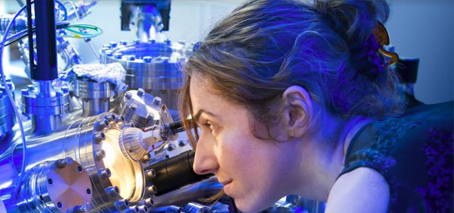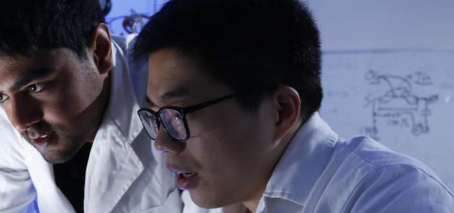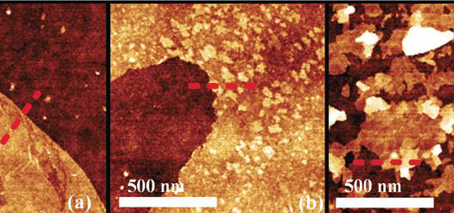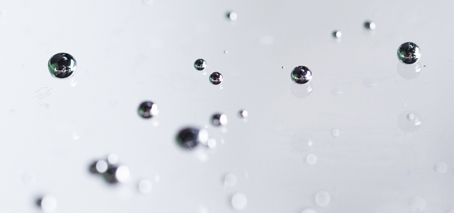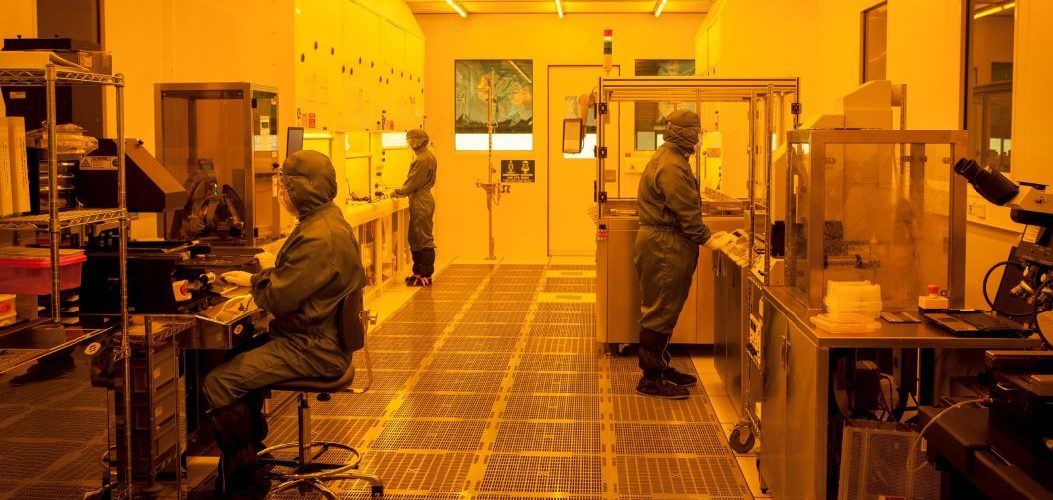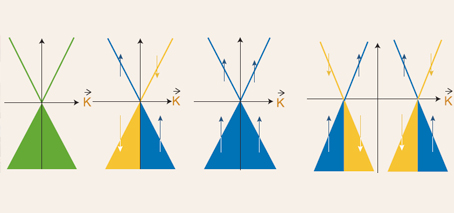Superfluids were first discovered as a special quantum state of liquid helium, later dubbed as “Superfluid helium” once chilled past -269 degree celsius, starts to manifest properties that do not occur in other fluids. Penetration through a solid with nano-pores is one of the three fascinating macroscopic phenomena that are well known in superfluids such as liquid helium. It is …
Mind the gap: FLEET team from Wollongong and Monash reveal a wide-band gap topological insulator
Since their discovery in 2006, topological insulators have been widely discussed as a promising avenue for energy efficient electronics. Their unique high mobility edge states have a form of “quantum armour” that protects them from electron-scattering events that would otherwise produce waste heat. Unfortunately, practical applications of topological insulators have been severely limited by the small electronic bandgaps in most …
Liquid metals the secret ingredients to clean up environment
Forget the laboratory, substances that can solve environmental problems by capturing carbon dioxide, decontaminating water and cleaning up pollutants can be easily created in a kitchen, a UNSW Sydney study shows. In a paper published today in Nature Communications, UNSW chemical engineers shone a light on the mysterious world of liquid metals and their role as catalysts to speed up chemical …
Controlling the charge state of organic molecule quantum dots in a 2D nanoarray
Molecular self-assembly on a metal results in high-density 2D organic (carbon-based) quantum dot array with electric-field-controllable charge state Organic molecules used as nano-sized building blocks in fabrication of functional nanomaterials The achieved densities of the 2D organic quantum-dot arrays are an order of magnitude larger than conventional inorganic systems. A Monash University experimental study has fabricated a self-assembled, carbon-based nanofilm …
Experimental observation of a new class of materials: excitonic insulators
First observation of excitonic insulator New exotic state was first predicted in 1960s A University of Wollongong / Monash University collaboration has found evidence of a new phase of matter predicted in the 1960s: the excitonic insulator. The unique signatures of an excitonic insulating phase were observed in antimony Sb(110) nanoflakes. The findings provide a novel strategy to search for …
Lights out: Putting the ambient air oxidation of Monolayer WS2 to bed
Oxidation of monolayer WS2 in ambient requires exposure to light, and keeping samples in darkness can protect from oxidation Routine exposure to room lights (days) or light microscopes can cause significant oxidation, suggesting wide reaching implications for current and future studies of monolayer S-TMDs To protect monolayer semiconductor transition metal dichalcogenides (S-TMDs) from oxidation, they must be entirely shielded from …
Women in FLEET Fellowships
FLEET’s goal is to achieve 30% representation of women at all levels across FLEET. To begin to move towards this goal, we needed innovative approaches that would allow us to begin ‘shifting the dial’. One innovative initiative that has met with success was FLEET’s new women-only Fellowships, offered in multiple locations, and across all fields of study in the Centre. …
Meet molybdenum, an acid-free route to future Hydrogen power?
Molybdenum based compounds could provide key to hydrogen production for future zero-emissions energy RMIT/Monash collaboration opens promising route towards alkaline hydrogen production A FLEET study combining experimental expertise at RMIT with theoretical modelling at Monash University opens a new route towards efficient, cost-effective production of hydrogen. Researchers discovered that ammonium-doped, hexagonal molybdenum oxide (MoO3) displays extremely promising electronic and material …
Tuning the topological insulator Sb2Te3: just add iron
Iron-doping of the topological insulator Sb2Te3 results in useful electronic and magnetic properties, quantified in a recent FLEET study at the University of Wollongong. The researchers studied the magneto-transport properties of an iron-doped topological insulator (Fe–Sb2Te3). After the material is doped via the addition of iron, its electronic structure changes significantly: multiple response frequencies emerge, in contrast to the single …
Deciphering the fundamental physics of ferroelectricity at the nanoscale
Welcome new AI Laurent Bellaiche Welcome to Prof Laurent Bellaiche, whose ongoing research collaborations with FLEET are recognised by him becoming a Centre Scientific Associate Investigator. At the University of Arkansas (US), Prof Bellaiche leads first-principles-based theoretical studies of ferroelectrics, magnetic compounds, multiferroics and other semiconductors. He has co-authored over 310 refereed journal articles, his publications have been cited more …
Welcoming two new Associate Investigators
Dr Dmitry Efimkin (right) is a Scientific Associate Investigator at Monash University specialising in novel materials such as Dirac materials, graphene and topological insulators, and optical phenomena in solids. Within FLEET, Dmitry works with CIs Michael Fuhrer, Meera Parish, and Nikhil Medhekar in Research theme 2: exciton superfluids and Enabling technology A: atomically-thin materials, studying optical and collective phenomena in …
FLEET collaboration reviews ferromagnetism in 2D materials
* Two-dimensional magnetism reviewed in new, collaborative review A collaborative FLEET study has reviewed recent progress in 2D ferromagnetism, and predict new, possible 2D ferromagnetic materials. The study also introduces possible applications of atomically-thin ferromagnets in novel dissipationless electronics, spintronics, and other conventional magnetic technologies. The scientists propose a new method of observing 2D ferromagnetism that could reveal new materials. …
Expanded partnership with Tsinghua University: meet FLEET’s two new Partner Investigators
FLEET’s fruitful relationship with Tsinghua University (Beijing) has been expanded, with the Centre welcoming two new Partner Investigators to lead research collaborations. Prof Shuyun Zhou studies the electronic structure of novel two-dimensional materials and heterostructures using advanced electron spectroscopic tools, including angle-resolved photoemission spectroscopy (ARPES), spin-resolved ARPES, nano-ARPES and ultrafast, time-resolved ARPES. She has made important progress on the electronic structure …
Monash engineers unlock avenue for early cancer diagnosis
Monash University engineers have unlocked the door to earlier detection of cancer with a world-first study identifying a potential new testing method that could save millions of lives. Researchers found that a sensor using new, more sensitive materials to look for key markers of disease in the body increased detection by up to 10,000 times. Associate Professor Qiaoliang Bao from …
Topological material switched off and on for the first time: key advance for future topological transistors
Significant step toward future topological electronics The first electric field-switchable topological material Topological transistors would be an ultra-low energy , beyond CMOS solution to ICT energy use after the end of Moore’s Law Over the last decade, there has been much excitement about the discovery, recognised by the Nobel Prize in Physics only two years ago, that there are two …
Quick and not-so-dirty: a rapid nano-filter for clean water
FLEET researchers have designed a rapid nano-filter that can clean dirty water over 100 times faster than current technology. Simple to make and simple to scale up, the technology harnesses naturally occurring nano-structures of aluminium hydroxide that grow on liquid metal gallium. The researchers behind the innovation at RMIT University and UNSW have shown it can filter both heavy metals …
Ferroelectric switching in Indium(III) selenide: potential for ultra-low energy electronics
The discovery of new ferroelectric properties in the novel, layered material Indium(III) selenide (β’-In2Se3) enhances this material’s candidacy for non-volatile memory and low-power electronic and optoelectronic switches. FLEET researchers at Monash University and UNSW were on the Australian-Chinese team that confirmed in-plane ferroelectricity in the material, β’-phase In2Se3. In2Se3 belongs to a class of layered materials known as van der Waals …
Pushing ‘print’ on large-scale piezoelectric materials
First ever large-scale 2D surface deposition of piezoelectric material Simple, inexpensive technique opens new fields for piezo-sensors & energy harvesting Researchers have developed a revolutionary method to ‘print’ large-scale sheets of two dimensional piezoelectric material, opening new opportunities for piezo-sensors and energy harvesting. Importantly, the inexpensive process allows the integration of piezoelectric components directly onto silicon chips. Until now, no …
Atomic-scale material engineering, inspired by nature
New materials inspired by nature could be key to future electronics Self-assembled nanostructures have atomically-precise structure and tailored electronic properties Bio organisms are the most-complex machines we know, and are capable of achieving demanding functions with great efficiency. A common theme in these bio-machines is that everything important happens at the level of single molecules – that is, at the …
Why 2D? Measuring thickness-dependent electronic properties
Why 2D? What is it about two-dimensional materials that makes them so interesting for FLEET? FLEET UNSW/Wollongong collaboration finds transition point from 3D to 2D properties Constraining the movement of charge carriers (electrons or holes) to two dimensions unlocks unusual quantum properties, resulting in useful electronic properties. Although we refer to the layers within such materials as ‘2D’, they are …
Science fiction becomes science fact as researchers create liquid metal heartbeat
Discovery has potential applications in artificial muscles, soft robotics and microfluidic circuitry In a breakthrough discovery, University of Wollongong (UOW) researchers have created a “heartbeat” effect in liquid metal, causing the metal to pulse rhythmically in a manner similar to a beating heart. Their findings are published in the 11 July issue of Physical Review Letters, the world’s premier journal …
Rebecca Orrell-Trigg (RMIT) interview re liquid metal and 2D materials, RRR
FLEET PhD student Rebecca Orrell-Trigg (RMIT) uses liquid metals to synthesise 2D (atomically thin) materials for use in future ultra-low energy electronic devices. Late last year they developed a liquid metal “bubbling” method that was described as “ground breaking”, and have since refined this method to make it even more widely applicable. Rebecca’s interview covered the advantages of the new …
Characterising tin-oxide growth: improved understanding of ground-breaking liquid-metal 2D technique
Last year, FLEET researchers at RMIT developed a ground-breaking new method of depositing atomically-thin (two-dimensional) crystals using molten metals, described as a ‘once-in-a-decade’ advance. Earlier this year, the same research team expanded the new method from controlled to ambient conditions, and has properly characterised the growth mechanisms for key tin oxides, which should allow improved control of target oxide growth. …
Liquid metal provides ‘once-in-a-decade’ advance in 2D material deposition
A variety of methods exist to deposit atomically-thin (two-dimensional) crystals. But large-scale deposition has remained a challenge. However a recent RMIT-led study has found success with a new technique with potential to open new doors for two-dimensional semiconductors. The discovery has been described as a ‘once-in-a-decade’ advance. The new technique introduces room-temperature liquid metals (gallium-based) as a successful reaction environment …
Materials one atom thick & nanotransistors: FLEET features in nano edition
FLEET features in this month’s annual ‘nano’ edition of the Australian Manufacturing Tech magazine. The article looks at growth of atomically thin and other novel materials and nanofabrication, with a particular focus on partnerships. Atomically thin material projects presented include semiconductor fabrication at RMIT University (Lan Wang) and the University of Wollongong (Xiaoliang Wang) and molecular beam epitaxy (Mark Edmonds …
Spin gapless semiconductors: promising materials for novel spintronics and dissipationless current flow
A University of Wollongong study has tightened the search for materials that would allow for ultra-fast, ultra-low energy ‘spintronic‘ electronics with no wasted dissipation of energy from electrical conduction. Spintronics is an emerging field of electronic study in which the ‘spin’ of electrons (their intrinsic angular momentum) is used in addition to their charge. Conventional electronics and information technology are …
Room-temperature ferromagnetic semiconductor strong foundation for spintronics
A barrier to practical spintronic devices has been lowered as room-temperature ferromagnetic semiconductors created in an international collaboration involving FLEET’s Xiaolin Wang. While semiconductor spintronics promise lower switching energy and faster speed, a major limitation on its development as a viable technology is the lack of room temperature ferromagnetic semiconductor materials. A collaborative study between researchers from two Chinese universities …


